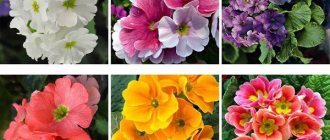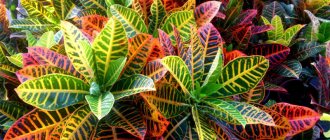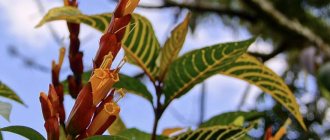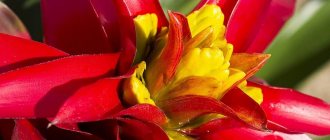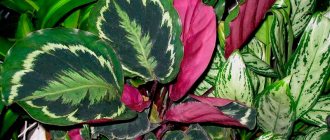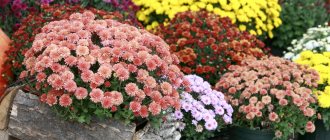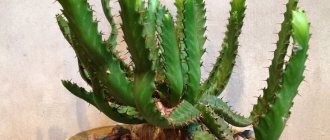You can grow any plant at home if you carefully care for it. Quite often in home gardens and on window sills you can see a beautiful and original Crassula (Crassula), or as it is popularly called, “money tree” . This is a unique representative of succulents, which has more than 300 varieties.
For its compactness and attractive appearance, many people have fallen in love with Crassula minor . It grows slowly and is not very demanding in care. When choosing this type of “money tree” to fill your miniature home garden, you should know the basic rules for caring for it. This will provide the plant with comfortable conditions for growth.
Characteristic
Crassula minor is an artificially bred variety that is a variety of Crassula ovata. The leaves of the plant are quite small - no more than 1.5 centimeters in length and 1 centimeter in width. They have an oblong shape. The coloring is very interesting, which allows it to complement any garden compositions with Crassula - the edges of the leaf above and below are framed in red, and the middle of the leaf is dark green. Depending on the lighting, the indoor plant changes its shade.
The trunk of young Crassula minor is green, fleshy and soft. Over time, when the lower leaves die, it becomes bare and woody. This property of the plant allows it to form miniature trees as it grows.
Crassula - types, photos and names
Both in nature and in indoor floriculture, crassulas are found in the form of tree-like shrubs and herbaceous plants. These can be very small succulents or large trees. But all plants have one common feature - fleshy leaves that grow opposite each other on the stem.
At home, Crassula does not have the same large size as in nature, since it grows in a small amount of soil, is limited in space and does not have many other conditions that in nature contribute to intensive plant growth. But even a homemade crassula or money tree from a small shoot or leaf will eventually grow into a tree with a thick trunk.
Crassula leaves, depending on the type, can be entire, simple or ciliated. Under good conditions and proper care, racemes or umbellate-paniculate lateral inflorescences consisting of red, bluish, yellow or white flowers are formed on the Crassula.
Home care
It is impossible to grow a healthy and beautiful “money tree”, which, according to many popular beliefs, attracts financial well-being into the house without proper care for it. These are simple steps that will not take much time, but will provide the plant with the necessary nutrients and create comfortable conditions for growth.
First you need to choose the right crassula minor in the store. The health of the plant is indicated by its appearance. The leaves should be elastic, without spots and rough plaques, without damage by insects and parasites. The trunk is elastic, without flaccid areas and depressions.
Landing
After purchasing Crassula minor, it should be replanted in suitable soil. Usually they take ready-made soil for cacti or prepare the substrate themselves: 1 part peat, leaf and turf soil and 0.5 part sand. The soil must be well drained; for this, small broken bricks or charcoal are added to the pot.
The usual transplantation of Crassula minor is carried out annually in the spring using the transshipment method, preserving a piece of earthen coma at the roots.
Watering
Crassula needs specific watering. Excessive fluid intake can lead to the death of the “money tree”. The soil should be moistened only when it has dried to a depth of more than 3 centimeters.
From spring to late autumn, Crassula minor is watered once every 1-2 weeks , as soon as the soil needs it. In winter, when the plant is moved to a cool room, it needs to moisten the soil mixture only once a month.
You should not allow the earthen clod to dry out, so that the Crassula roots are not damaged. If the plant does not have enough moisture, this immediately becomes noticeable by the darkened leaves, which wrinkle and cease to shine.
Pruning and crown formation
Crassula minor is easy to form a crown. This allows you to make it a real decoration for your home mini-kindergarten. As soon as 3-4 pairs of leaves grow on a branch, the next bud that hatches is pinched off. At this point, 3-4 buds will again form, and the plant will begin to branch in different directions.
Long branches of the Crassula can be pruned. To do this, use a sharp knife or blade, and the cut area must be sprinkled with charcoal or crushed activated carbon.
How to transplant a fat plant correctly
Crassula is transplanted into a new pot as needed. To do this, you need to take a container two centimeters larger than the previous one, the bottom of which is filled with drainage and soil for succulents. After this, the plant is carefully removed from the old pot. It must be taken so as not to damage the shoots and break off the leaves. Together with a lump of earth, the bush is placed in a prepared pot, its roots are covered with soil and watered.
Attention! Do not choose large pots for the fat plant! Its roots in such a container will grow deep and its stems will grow upward. As a result, the bush will stretch out and be ugly.
To maintain the compact size of the plant, it does not need to be replanted at all. It will be enough for the fat woman if every spring the top layer of soil is replaced with new nutritious soil.
Reproduction methods
Crassulas propagate by cuttings and leaves. These are the simplest methods that guarantee rooting and further growth of the plant.
The krasula leaf is torn off and placed in water for a day. Then it is transferred to a pot and covered with earth. Watering abundantly.
Propagation by cuttings is no less simple. The cuttings are separated from the plant, dried for 1-2 days and placed in a mixture of soil and sand or in a prepared mixture for cacti. The first watering is carried out after 3 days, allowing the plant to adapt a little. The next moistening of the soil is carried out as it dries.
Features of reproduction
One of the main advantages of this plant is its ease of propagation. Various methods are used. The seed method is used very rarely, since propagation by cuttings is much simpler.
We recommend: How to care for hippeastrum to achieve flowering?
Cuttings are taken from the bush at any time of the year. However, in winter you will need additional lighting and protection from the cold. The cut cuttings are kept in the open air for 2-3 days, withering, after which they are planted in containers with a light substrate consisting of leaf soil, turf and sand in a ratio of 2:1:1.
Sometimes cuttings are pre-rooted by placing them in water with the addition of activated carbon for disinfection. After the roots appear and the seedlings begin to grow, they are planted one at a time in a container with a diameter of 5 cm.
If you want to propagate Crassula by seeds, mix leaf soil and sand in a 2:1 ratio. Scatter the seeds over the surface of the ground. Cover the container with glass, spray regularly and ventilate daily. Shoots appear in two weeks. Small plants are picked up and moved to a very bright place. When the young shoots begin to actively increase in size, they are planted one bush at a time in a permanent place. The composition of the soil used is the same as for cuttings.
Diseases and pests
Crassula minor is susceptible to parasitic diseases. Its leaves are often attacked by scale insects, spider mites, aphids, and the root system is attacked by root and mealybugs, and fungus. Signs of the disease can be not only visual insects and their metabolic products on the surface of the crown, but also lethargy, rotting, and spots on the foliage.
It is much more difficult to get rid of a fungus that has affected the root system. The reason for its appearance and spread may be excessive watering with cold water straight from the tap. If fungal damage is detected, the fat plant should be pulled out of the pot, the roots freed from the earthen ball, washed, treated with special antifungal agents and replanted in a new soil mixture.
Crassula minor requires human help for proper development and growth. This miniature and original plant will be a bright addition to the garden of “living stones” of succulents or will delight the eye as a single formed tree.
Useful video
Below you can watch a video on how to care for, replant and make Crassula Minor bloom.
If you find an error, please select a piece of text and press Ctrl+Enter.
Among lovers of indoor plants, there is not a florist who does not know about Crassula Ovata. People usually call it simply Crassula, because of its dense leaves, or the Money Tree, because according to legend, it brings money to a person’s house. This superstition appeared relatively long ago, due to the shape of the crown, which is so surprisingly similar to small coins.
This species came to European culture when the colonization of South Africa was actively taking place. Together with the wonderful world of the peoples of Zimbabwe, Mozambique and Madagascar, the colonialists brought to the world Krasulla Ovata , which does not need much moisture. In addition to folk symbolism, the plant has also found its recognition in bonsai planting techniques.
Money tree in the house: signs and superstitions
It is believed that the fat woman brings prosperity to homes and helps in business. Therefore, this tree can be seen not only in apartments, but also in offices. According to folk superstitions, a money tree will bring prosperity and prosperity to your home under the following conditions:
- The owner of the apartment himself grew the plant from a seed or shoot.
- Crassula will show its best energy abilities in the southeastern part of the apartment.
- Dust that interferes with financial flows must be regularly washed off the leaves of the plant.
- The fat woman needs to talk about her financial problems. If they are resolved, then thank you for your help.
- It is not recommended to place a money tree next to radios, mobile phones, and televisions. They take all the energy from the plant.
- Since money loves to count, when washing a bush you need to count the leaves on the fat one.
- From each amount earned, you should allocate a metal coin, which should lie next to the flower.
- To feed the money tree with additional financial energy, it is recommended to plant it in a red pot or simply tie it with a red ribbon.
- Another sign that will attract financial well-being to the house is tying banknotes between the leaves of the fat plant, which should be renewed periodically.
It is not recommended to give a crassula or even its shoot as a gift. As a last resort, the one to whom the money tree is given must give a coin in return. But you can give Crassula for a wedding. This gift is accompanied by banknotes tied with a red ribbon.
All these signs and superstitions about the money tree have not been scientifically proven. But it is known for sure that the fat man has beneficial properties. The plant releases substances into the air that have antifungal, antiviral and antibacterial effects.
Crassula leaves have medicinal properties and are used for rubbing for arthritis, for the treatment of stomatitis and sore throat, as a lotion for abscesses, cuts, insect bites for the treatment of herpes. However, the leaves of the fat plant contain arsenic, so they should not be taken orally!
Description and features
The homeland of Crassula Ovata is South Africa, which already has more than 350 varietal species. Species diversity depends on the places in which Crassula grows. In drier conditions, unusual leaf colors and shapes stand out. Among all this diversity, there are both dwarf subtypes and powerful trees that stretch their trunk high into the sky.
The only thing that remains unchanged in a large natural assortment is the opposite leaf arrangement, the thickness of the leaves and the absence of cuts in the leaf plates. You should know that the leaves of Crassula Ovata are unsuitable for food because they contain a large amount of arsenic, which negatively affects the health of people and their pets.
Blooming Crasulla Ovata
Surprisingly, the number of pistils corresponds to the number of stamens. The flowers are quite small and collected in small bunches. Most species fit into three conditional groups:
- Tree-like - reaches a height of up to one meter. It stands out for its color on the underside of the leaves. It is characteristically red. Over time, the trunk curls and acquires a characteristic brown tint. The species actively blooms in autumn-winter. The flowers are white.
- Creeping - distinguished by their speed of covering the grass area. Its shape is very different from its predecessor, from the elongated club mosses to the thin yellow leaves of Crassula Otpryskova. It is grown mainly in summer cottages to reduce air humidity.
- Spike-shaped - have a straight stem that can reach only half a meter. The shape of the leaves is very amazing, they seem to be strung on top of each other. In terms of color, it can be either a green plant or with brown spots.
In addition to the main subspecies, there is a wide variety of different varieties that are unique in nature. It is worth considering more significant species that can be observed in the homes of most indoor plant lovers.
What varieties are there of this species?
Variegata
Hybrid variegated variety of Crassula Perforata . Stems are erect, up to 30–50 cm in height. The leaves are diamond-shaped, glossy, up to 3 cm in length. The leaf color is green. Young leaves are decorated with yellow stripes along the edges and in the center of the leaf blade.
Often grown as a hanging plant, it grows quickly. The flowers are star-shaped, small, white, formed at the very top of the shoots.
Minor
Crassula minor is a bred compact variety that has the synonymous name compacta. Grows well even in semi-shady places . The stems are straight, bushy, and grow slowly. The leaves are fleshy, shiny, green in color with a reddish edge. The leaves are 1.5 cm long and up to 1 cm wide. The inflorescences are umbrella-shaped and contain many white or pink miniature flowers.
Alba
The stem is shortened. With the development of peduncles, the stems stretch upward and grow to 35–40 cm in height. The leaves are oblong, shiny, smooth, collected in a wide rosette. The leaf blade is medium in size, up to 5–6 cm in length. The color of the leaves is reddish or green with white and red patterns. The variety has a peculiarity - immediately after flowering the rosette dries out. Propagates easily by lateral rosettes.
Varieties of Crassula Ovata
1. Species Crassula Ovata The Hobbit is very large in its natural population. Absolutely unpretentious to conditions, because of its shape it looks like an independent bonsai. The variety was bred from Crassula oval, which greatly affected its appearance. The leaves are oblong and have a shallow hole at the end. Despite its evergreen color, it can change if kept in full sunlight. The color scheme reaches crimson. The maximum height is about two meters in the wild, but at home it hardly reaches one meter. Blooms less than once a year.
Krasulla Ovata The Hobbit
2. Crassula Ovata Gollum is noticeably different from the previous variety in its leaf shape. The shape of the leaves is quite dense, they look like elongated halves of tubes. It does not require the creation of certain climatic conditions at all. It can reach a maximum height of half a meter, which is associated with a very long growth of stems.
Crassula Ovata Gollum
3. Crassula Ovata Minor. The variety was bred artificially.
A typical representative of the family of tree-like plants. Can survive without watering for about one month. In indoor conditions it can live for about 50 years. This is the same flower whose leaves are compared to small coins. When near a source of natural light, the foliage may turn red. Ideal for creating a bonsai garden indoors.
Types of Crassula - photos, names
There are a large number of types of Crassula, of which we will describe the most popular and in demand for growing at home.
Crassula tree - photo
Crassula of this species is a large plant with a thick, bare trunk and branches on which flat, obovate, round leaves grow. The leaves are three to seven centimeters long and have a light gray color, a bluish tint and red edges. Crassula tree rarely blooms at home. In nature, it produces panicles with white or pale pink flowers.
This type of Crassula loves bright light and does not tolerate shadows at all. With good care, even at home, the tree can grow up to one and a half meters in height. The following varieties of Crassula tree are known:
- curly - the plant got its name because of the wavy large leaves;
- Undulatifolia is a type of Crassula with silver-blue or variegated flat, narrow leaves.
Crassula ovata - photo
This is an ovoid or oval Crassula, which is most often found at home. In nature, the shrub reaches a height of three meters. In an apartment, a tree can grow up to one and a half meters in height. It has a large number of fast-growing shoots with green or silver-gray oval, shiny leaves. Crassula ovata blooms with pink or white flowers, which are collected in umbrella-shaped apical inflorescences.
You will be interested to know: Is it possible to keep a monstera at home?
This species is easy to care for and shade-tolerant. The most famous varieties of the ovata money tree are:
- Crassula Sunset is a plant with beautifully colored leaves, which are distinguished by a bright red border and yellow or white stripes along the edge. This type of Crassula requires good lighting, otherwise the foliage will turn a plain green color.
- Crassula Goluma is an American hybrid variety that is distinguished by its leaves rolled into a tube. The leaves expand funnel-shaped towards the base.
- Crassula Tricolor - from the name of the flower you can understand that its leaves are tricolor. They have red edges and white stripes in the middle on a green background.
- Crassula Hobbit is a hybrid with leaves turned outward, which are fused from the base to the middle.
- Crassula Minor is a compact plant suitable for a mini-garden with leaves no more than one centimeter wide and up to one and a half centimeters long.
Crassula moss - photo
A ground cover plant up to 25 cm high has creeping tetrahedral shoots. The species got its name because it looks like a moss.
Crassula moss is distinguished by small, scale-like leaves that fit tightly to the shoot and are folded in four rows. In intense light, the leaves take on a reddish tint.
Crassula perforata or perforatum - photo
Columnar-shaped fatty plant with diamond-shaped leaves, which seem to be strung on shoots. The leaves have a light green color, a bluish tint and a gristly red border.
Crassula Spring Time - photo
The hybrid form of the Crassula is distinguished by a compact ground part, shoots prone to lodging, bright green, succulent foliage and light lilac flowers.
Crassula rupestris
A herbaceous plant with erect or creeping shoots that can reach 60 cm in length. Its ovoid small leaves, smooth and reddish along the edges, are 1-2 cm wide and 1-2.5 cm long. Umbrella-shaped inflorescences are formed in the upper part of the shoot with yellow flowers.
In addition to those described above, there are also quite a large number of species of domestic crassulas, which differ in the shape, size and color of the leaves, as well as the size and shape of the plant itself.
Home care
If there is a question of establishment under normal conditions, you should understand that simple mayonnaise buckets will not suit her. Due to its powerful root system, caring for Crassula Ovata is a little more difficult than with other indoor flowers. It must be kept in clay pots that can withstand the weight.
Due to the weak branches, when it falls, almost all the stems instantly break, so it needs to be kept as far as possible from those places from which it can fall.
In addition to the basic transplantation processes, we should not forget that the flower may need drainage. Simple room conditions may not be enough, so you should lay out a layer of broken pebbles and brick chips.
Priming
Of course, the flower is not so whimsical in its nutrition, but you need to understand that suitable soil will extend the life of the “green pet”. You should purchase soil for succulents at hardware stores. However, if these are difficult to find, you can do everything yourself.
- Leaf, or purchased land, which does not have specific characteristics.
- River sand is suitable, both natural and store-bought.
- Turf soil, which can be collected from a garden plot.
- The smallest pieces of charcoal, or even expanded clay.
If after such soil the flower begins to shed its leaves, the reason is that it requires organic drainage.
Transfer
Seating should only be done under certain conditions.
- Young plants are replanted no more than one year. The size of the container should not be significantly larger than the previous one.
- Adult plants require replanting once every couple of years. The soil is replaced and the longest roots are trimmed. Afterwards, they should be immediately inoculated with charcoal.
- If the soil has been changed relatively recently, but the larch looks too frail and lethargic, you need to change the top layer of soil by a couple of centimeters.
Watering
Due to their unpretentiousness to moisture, flowers should be watered carefully. In winter, the supply of the usual amount of water is reduced; the flower is watered only when its leaves begin to shrink. In spring and summer, on the contrary, it is worth giving more water. It is then that small inflorescences begin to bloom.
Fertilizer
Organic fertilizer for succulents and cacti, which is widely sold in stores, is excellent. In spring and summer, the plant is fertilized approximately twice a month, according to the instructions for caring for Crassula Ovata in the packaging photo. In winter, fertilizer is practically removed, which should be applied approximately every two months.
How to care for Crassula?
All succulent plants, including Crassula plants, are unpretentious in care. You only need to follow a few simple rules:
- Watering should be regular, but not frequent. In warm rooms, water the soil only when its top layer is thoroughly dry. If the plant is kept in cool conditions in winter, then it should be watered only when the soil dries to a depth of two to three centimeters. Crassulas are plants that are better underwatered than overwatered. Therefore, you should not get carried away with watering the money tree, which can react to constantly damp soil by dropping leaves and rotting the trunk.
- Crassulas only need feeding Fertilizers are used for cacti and succulents. There is no need to feed the money tree in autumn and winter.
- to spray the plant, since all succulents tolerate dry air well. However, in order for the leaves to have a decorative appearance, it is recommended to wash them periodically. You can do this under a warm shower, having first wrapped the pot in cellophane so that water does not fall on the ground.
You will be interested to know: Flower of male happiness - anthurium: meaning, types and varieties
Pests and diseases of Crassula Ovata
Due to its natural nature, the Crassula ovata plant usually lives in places where there is a slight lack of water in the soil. Therefore, excess moisture infects indoor flowers with fungal infections. The disease affects the roots of the flower, causing a large number of leaves to be shed, and eventually it dies.
Parasites rarely settle on healthy larch. If some types of mites were found in the foliage system, then the entire surface is treated with a soap solution. Also, be sure to check all neighboring plants, because they can also be infected with parasites. Since the plant is unpretentious to its storage conditions, infection can only be carried out under conditions of excessive watering or constant drafts.
Crassula perforata
In the wild it grows on the rocky slopes of the Drakensberg Mountains of the Republic of South Africa.
Appearance
Eucharis flower. Description, features, types and care of eucharis
The houseplant is a bush with 10 or more long, unbranched shoots growing from a single root and spreading along the ground. Each shoot is densely strung with small paired leaves in the shape of a heart. The stems and leaves of perforata come in all shades of green. They are fleshy, filled with moisture, and glossy. Sometimes the tips of the leaves become reddish. Flowering occurs in the cold season (November-April). The bush produces inflorescences with cream flowers.
Additional information : The variegated variety of perforata is a cultivated hybrid. The variegation of the upper parts of the shoots is due to alternating light and dark green stripes on the leaves.
Features of care
The bush loses its presentable appearance if it is not pinched. On a strongly branching shoot, the top 2 leaves are removed and the shoot bifurcates.
The plant loves good lighting, but constant exposure to direct sunlight causes leaf burn. It is recommended to place the flower pot on the window so that only the morning rays of the sun fall on it.
Fertilizing is recommended in spring and summer with fertilizers for cacti. In winter, dry air and close proximity to radiators do not affect the condition of the flower. Watering is carried out once a week in summer and once every 2 weeks in winter. No spraying required. Moisture exchange occurs through the pores on the leaves and shoots. It is recommended to regularly wipe the flower with a damp cloth. He is afraid of drafts.
The bush is replanted in early spring every 2 years. Reproduction occurs by seeds and cuttings.
Reproduction methods
The biggest advantage of starting a wealth tree is the ease of replanting. Transplanting Crassula Ovata at home is carried out using leaves or cuttings, approximately in the spring. When cutting and shaping leaves, the starting materials are dried for a couple of days, and then placed in a container with substrate and drainage.
Of course, you can propagate using seeds, but this is not so relevant and popular. The seeds are sown in special containers, where they are sprinkled with water every day and given a small influx of fresh air. The rest of the time, the seeds are kept under the film. Afterwards, they are transplanted into separate containers.
Propagation of Crassula by cuttings
The easiest and most productive way to propagate crassula is by cuttings. For this species, not only leaves, but also shoots can be used as planting material. These may simply be fallen parts of the flower. Before planting the seedling in the ground, it is recommended to treat the cut area or wound with charcoal powder. Some gardeners also advise “withering” part of the plant for 2-3 days.
Crassula reproduction
Due to the fact that the flower is absolutely unpretentious, the seedling can be rooted in different ways:
- after short drying;
- after rooting it in a glass of water;
- without preliminary preparation, plant directly into the ground.
Note! If, before planting, preliminary preparation of the seedling is carried out, then you should wait until the first roots appear.
Price of plant and seeds
The price range of plants in pots varies greatly. Let's say the price of Crassula Sunset and Gollum does not go beyond 1.5 thousand rubles, while the Hobbit costs about 5-6 thousand. Crassula Minor is usually slightly cheaper than its relatives. This is due to the prevalence of the variety.
Leaf cuttings are quite cheap, their price varies from 50 to 400 rubles. They can be freely ordered both in online stores and from hand, having found similar advertisements.
Plant seeds do not go beyond standard prices; they can be freely purchased in specialized stores, along with accompanying equipment for planting and growing.
Crassula Ovata is truly a wonderful plant that has an attractive beauty. The sight of its stems can amaze every lover of indoor floristry. Among the advantages, unpretentiousness to climatic conditions and a small amount of moisture consumed immediately stand out. But like any other plant, the varieties of this plant need to be looked after.
Crassula gollum
This species was bred by American scientists from the ovata species. Also named after a character in The Lord of the Rings.
Appearance
The root of the flower is superficial and grows well. The bush looks similar to Crassula hobbit. It also has the shape of a small tree up to 50 cm high. It grows very slowly, forming a well-branched bush with many bright green paired leaves. Their shape is slightly different. This is his main difference from a hobbit. The leaves resemble tubes with a funnel-shaped hole at the end. The leaf is narrow at the base, and towards the end it widens noticeably, resembling a saucer. In the sun, its tip turns red.
Flowering of gollum occurs rarely - not earlier than 5-7 years of life. Under optimal conditions, the bush produces an umbellate inflorescence with white or pink flowers resembling stars.
Crassula gollum
Description and characteristics
of Crassula , which differ in the shape and size of the leaves, thickness and height of the trunk . The most popular plant of this family among gardeners is Crassula ovata v. Minor cv. Crosby s Compact or Crassula ovata minor.
Botanical description
Crassula ovata minor is a compact, neat tree, which is covered with small round leaves and is called the “money tree”. The homeland of Crassula ovata is South Africa, and scientists bred the Crassula Minor variety artificially. Thanks to its amazing ability to retain moisture reserves in the intercellular tissue of leaves and stems, Crassula easily tolerates lack of watering for 3 weeks.
Appearance
Crassula ovata Minor differs from its wild counterparts in its small size: The length of the leaf is no more than 1.5 cm, the width is 1 cm. The leaf blades are located opposite on the branches.
The trunk of a young plant has a bright green color, a juicy and soft structure. After the lower leaves die and fall off, woody bark gradually forms on the trunk.
If Crassula Minor receives enough light, the edges of the leaves acquire a red tint, while maintaining a green color in the middle. Being in partial shade, the tree also feels good, but the foliage will turn an even green color.
Of all the types of indoor Crassula plants, the Minor variety is considered the most capricious, as it grows very slowly . Crassula ovata Minor is a long-lived plant. In its homeland in Africa, the fat woman can live up to 90 years. A indoor tree with proper care and timely replanting will delight its owners for up to 40 years.
Now check out the photo of this plant:
What it is?
Botanical characteristics, homeland and distribution
Crassula perforata, synonymous with Crassula perforata, belongs to the genus of succulents of the huge Crassula family.
According to different classifications, the genus includes 300–500 species.
Natural habitat:
- tropics of Africa;
- Madagascar;
- southern regions of Arabia.
The Crassula genus is a tropical evergreen plant that grows only in the Southern Hemisphere.
In everyday life, the flower is called the money tree, the tree of happiness.
Literally translated, Crassula means “thick,” which characterizes the fleshy, dense structure of the leaves.
Description of appearance
The variety of Crassula perforatum is classified as a columnar variety.
The trunk is straight, long, dense, does not branch, and grows through the leaves. The stems grow more than 20 cm in height, densely leafy.
The leaves can be diamond-shaped or round, dense, thick . The color of the leaves is green, with a bluish coating. From the bright sun, the leaves at the edges acquire a reddish tint. The leaves are up to 3 - 4 cm wide, grow oppositely, in tiers, fused with each other at the base.
Important! The flower can be grown as an ampelous plant.
The inflorescences are umbellate panicles; there are varieties with racemose inflorescences. The flowers are located at the top of the stems. The flowers themselves are miniature, numerous, white with a yellowish tint, and fragrant at the very beginning of flowering. Flowering most often occurs in winter and lasts up to 1.5 – 2 months.
Photo
Here you can see a photo of the Perforated Crassula:
Is it easy to grow and how long does it last?
Crassula perforatum is an unpretentious flower, grows quickly, bushes well, and gives good annual growth.
A flower grown at home is significantly smaller in size than natural specimens. But over time it grows into a dense, decorative bush. It rarely blooms in an apartment ; flowering requires additional stimulation - a certain temperature regime and limited watering.
Important! To maintain the shape of the bush, pinching the shoots is mandatory.
It propagates easily, takes root quickly, and can be combined with other indoor flowers. With proper care and renewal, the bush can live for more than 10 years.
Features of caring for a fat woman
You need to care for Crassula ovata Minor in the same way as other representatives of the Crassula family:
- When purchasing a new plant, you should pay attention to its appearance. The health of the young tree should not raise any doubts.
- Watering should be moderate; a short-term lack of moisture will not affect the health of Crassula Minor in any way, but the earthen clod should not be allowed to become too dry. It is forbidden to flood the tree, as excess moisture will provoke the development of fungus and can cause rotting of the roots and trunk.
- The most successful way to propagate this variety of Crassula is by propagation by cuttings, which, after pruning, easily take root.
- The plant does not need a large pot due to the existing weak root system. The flower has many small and thin roots that slowly fill the space of the pot. The plant is replanted using the transshipment method no more than once every three years. The best time to transplant a flower is spring.
Features of caring for Crassula Minor boil down to controlling the frequency of watering and providing the flower with enough light.
Crassula lycophyte
Gloriosa - what kind of flower, main types
This is a herbaceous hanging succulent suitable for growing in hanging pots. It is not widely used among flower growers. The birthplace of the flower is tropical South Africa.
Crassula lycophyte
Description
The root of Crassula lycophyte is fibrous. It consists of many small roots that do not penetrate deep into the soil. The plant produces aerial roots that can absorb moisture from the air.
Unlike other species, it does not have a thick common trunk. The bush consists of many bright green or variegated shoots covered with small adjacent leaves. The flower grows quickly. New branches are formed from lateral growth points on the roots. At first they stick up and then bend towards the ground. The branches fill the pot and look like algae or moss. Therefore, this species is also called mossy. Small light green flowers usually appear in winter. They have a distinct smell.
Additional information: The variety of Crassula pseudomosula is distinguished by a smaller number of shoots and leaves and weak branching.
Features of caring for Crassula at home
The flower prefers moderate watering: in summer - 2 times a week, in winter - once a week. In hot weather, it is useful to spray it with water 1-2 times a week. The root system dies in overdried soil.
Preferably bright lighting without direct sunlight. The soil must be loose and breathable. Drainage of at least 3 cm is required. Pruning and pinching of flowers is carried out only in cases of illness, drying out, or damage to the shoots.
It needs to be replanted every 1-2 years. A four-year-old flower loses its decorative effect, so it is recommended to renew it every 3 years.
Similarities with other plants
The genus Crassulaaceae has more than 250 species of plants. All of them are succulents and have similar external characteristics. Some of them may be difficult for an inexperienced gardener to distinguish from each other. The Crassula ovata Minor has the greatest similarity with several representatives of this genus:
- Crassula Sunset , which means “sunset”. This is a compact type of Crassula artificially bred by breeders, which differs from the Minor variety in the color of its leaves. With proper care, Sunset Crassula foliage turns bright yellow-pink colors. Like Minor, Crassula Sunset is suitable for creating miniature gardens.
- Ovata var. Oblique cv. Tricolor has pointed leaves with white stripes and red edges.
- Crassula ovata var. Oblique cv. Solana The pointed leaves of the miniature tree are decorated with yellow stripes.
- Crassula Argentea or silver crassula is distinguished by the fact that the leaf blades are covered with a barely noticeable white coating, which gives the tree a silvery shimmer.
- Crassula ovata is distinguished by the large size of an adult tree.
Growing indoor indoor flowers is a real art that will not bring the expected results if you do not put your soul and love into it. No matter how hardy the plant is, only with careful attention to it can you achieve positive results and fill the interior with new colors.
If you find an error, please select a piece of text and press Ctrl+Enter.
General information about the plant
Crassula is unpretentious and caring for it at home does not require any special effort. Regardless of the variety, the algorithm of actions and conditions of detention are unchanged.
In nature, the evergreen crassula (Latin crassula - thick) amazes with its diversity of species. The vast majority of plants belong to the succulent family Crassulaceae, numbering over 360 species.
Semi-tree, bush and herbaceous larches can be found in the driest parts of our planet. There are especially many Crassulas in South African savannas and woodlands.
The more complex the living conditions, the more decorative the appearance, the brighter the color and the more intricate the flowers.
In terms of external characteristics and structural features, the Crassula varieties differ greatly from each other. Only a few features unite all species and varieties of the Tolstyankov family:
- opposite arrangement of leaves (each pair of leaves is at an angle of 90 degrees relative to the previous one);
- absence of dissection;
- small flowers of different shades are collected in inflorescences with the same number of stamens and petals;
- the root system is shallow.
Carefully! Crassula is poisonous. The juice of the leaves of the plant contains arsenic.
